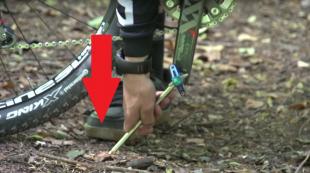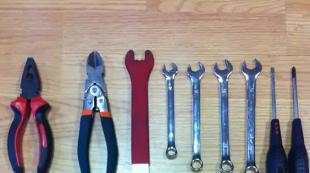DIY yacht anchor drawings. We make a homemade anchor for a PVC boat with our own hands according to drawings with video instructions
A sea anchor is a device that is vital for a small vessel, be it an inflatable boat or a sailing yacht. It helps a small sailing vessel to drift, and a boat to stay in place in strong currents, wind, and high waves.
The floating type is safe for inflatables and PVC boats because. cannot damage them, unlike metal and other types of anchors. About what types of anchors are used for small boats This article will tell you how the floating device works, whether you can make it yourself and how much it costs in stores.
The main task of this device is to hold the boat or yacht in place, regardless of the wind, waves, current speed, etc. Since ancient times, since man launched the first boat on the water, he has used an anchor. And if thousands of years ago they used an ordinary stone, which was tied with a rope, then in the modern world there are many types of it, for every taste and suitable for a vessel of any type and size, from inflatable boat to the transatlantic liner.
Since the Middle Ages, when they began to use iron in the manufacture of anchors, many varieties have appeared. The main modern types are:
- Admiralty;
- "plow";
- mushroom;
- Danforth anchor;
- Hall anchor;
- "cat";
- gravitational;
- not lost;
- pyramidal;
- sucker;
- floating.
The main task is to hold the vessel in place by gripping the bottom, but only an anchor, called a floating anchor, performs this task without direct contact with the bottom soil.
In the event that a boat or sailing yacht must slow down and remain in place, and the weather and natural conditions are unfavorable (strong current, wind, high waves), using a conventional anchor is difficult, because when stopping, a light vessel on a conventional anchor becomes unstable, he begins to spin and toss on the waves. And if a yacht or boat turns sideways towards the wave, the vessel may capsize.
 The next advantage of the floating option is that it can be used at great depths, where a regular one will not reach the bottom, and accordingly, the vessel will not be able to stay in place.
The next advantage of the floating option is that it can be used at great depths, where a regular one will not reach the bottom, and accordingly, the vessel will not be able to stay in place.
Also, a floating anchor is used in case of unforeseen situations, when the ship cannot move further (accident), but cannot deviate from the chosen course and is forced to drift until help arrives.
The floating option is used on small vessels, such as boats (inflatable, PVC, etc.) of various types, as well as sailing yachts. Practice has shown that on large ships the use of a floating option is ineffective. Small vessels are always equipped with two types of structures - a regular and a floating anchor.
It is worth considering that when using a regular anchor for a boat, when tossing it on the waves, a regular iron anchor can damage its bottom, while when using a floating one, this is impossible.
Sizes are of great importance, because... the effectiveness of its use depends on this, just like when choosing a regular one, the main parameter is weight. It must be sufficient to hold the vessel in place. For a floating anchor, the main parameter is the size to cope with the force of the current and hold the ship or boat in place.
What does a drogue look like and how does it work?
This type has a truncated cone shape and is made from waterproof fabrics such as tarpaulin, canvas, etc. A metal hoop is sewn into its base, this is done to strengthen the structure. Essentially, it is a net with the end cut off, but the handle is replaced with slings that are attached to the main rope connecting the device to the boat or yacht. The number of lines is usually 4 pieces, and a cable is also attached to its base for pulling it out of the water. The structure is equipped with a buoy, which indicates its location in the water relative to the vessel.
Lowering into the water is carried out from the bow of the vessel, the device is positioned with its base towards it, held by an anchor rope, the buoy is located on the surface. The dome fills with water, expands, the ship turns its nose in the direction of the wind, and is held in place due to the resistance of the dome to the current. As a result, the drift is reduced, the boat does not turn sideways towards the wave, and takes on a fairly stable position. Its mechanism of action is similar to a parachute in the air.
In stormy sea conditions, additional oil or animal fat can be used. They are known to dampen waves by forming a thin film of fat on the sea surface that prevents the formation of ridges. As a result, the kinetic energy of the wave is dampened, which prevents it from overturning or destroying the ship.
Kinds
There are several types of sea anchors, differing in shape:
- cone-shaped. It has the shape of a truncated cone; to strengthen the base, a metal hoop is sewn along the edge;
- pyramidal. It has the appearance of a truncated pyramid, the base is reinforced with a metal or wooden cross;
- parachute. It is made in the form of a dome, similar to a parachute;
- stormy. This type is a strip to which a triangular panel is attached, and an iron anchor is tied to its lower edge for weighting. A sling is attached to the end of each corner, 3 slings are tied to the main rope;
- Jordan's drogues. A type of storm anchor, it consists of several cone-shaped floating anchors on one rope; during a storm it is more effective than a single device.
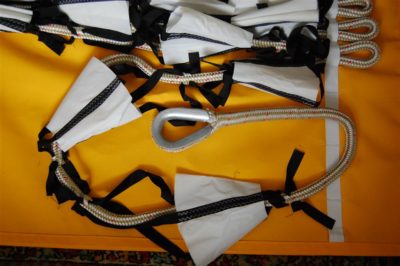 In stormy conditions, it is also possible to make a floating anchor from scrap materials - oars or using a release hook. A piece of tarpaulin, a canvas cover, or even a sail is tied to this improvised crosspiece. An ordinary iron anchor is attached to one of the corners for greater weight, and slings from the ends are tied to a rope. When lowered into the water, this homemade structure will take a vertical position and will act on the principle of a real floating anchor.
In stormy conditions, it is also possible to make a floating anchor from scrap materials - oars or using a release hook. A piece of tarpaulin, a canvas cover, or even a sail is tied to this improvised crosspiece. An ordinary iron anchor is attached to one of the corners for greater weight, and slings from the ends are tied to a rope. When lowered into the water, this homemade structure will take a vertical position and will act on the principle of a real floating anchor.
The material used for manufacturing is waterproof fabric, ranging from polyethylene to tarpaulin and canvas. The service life of such a product depends on the material.
How to do it yourself?
Some hobbyists prefer to make various devices themselves, this also applies to such a device as a floating anchor. The main task in this case is to determine all working dimensions. If for conventional anchors the main parameter is the weight, which should be 1% of the weight of the vessel with maximum load, then in the case of a floating option, the dimensions of the dome (external and internal diameters), the length of the slings and the main rope will be fundamental.
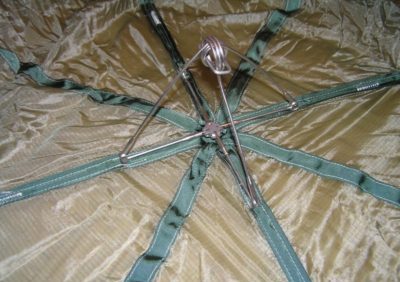 Typically, a pattern originally drawn on paper is used for sewing. You will also need material, it should be a dense, rigid fabric with waterproof properties (tarpaulin, canvas, etc.), rope and special glue.
Typically, a pattern originally drawn on paper is used for sewing. You will also need material, it should be a dense, rigid fabric with waterproof properties (tarpaulin, canvas, etc.), rope and special glue.
The pattern is laid out on the fabric and the blank is cut out. If the fabric is very dense, you can sew a dome from several parts. With this manufacturing option, you need to leave seam allowances for each part. Then the workpiece is stitched with strong threads; it is better to use synthetics, because... it has high weather-resistant qualities.
Next, a hoop for the base of the structure is made from durable material. If the shape is pyramidal, then make a cross to which the edges of the fabric blank are attached. After this, the slings are sewn on, most often there are 4 of them. If, when hanging, the anchor hangs strictly parallel to the ground, then it is balanced; if not, then the distance between the lines is adjusted. Finally, the slings are assembled into a knot and sewn to the main rope. All seams must be treated with waterproof adhesive, such as sealant.
Where can I buy it?
If you don’t want to waste time making an anchor with your own hands, you can buy it at the store. They are usually sold in specialized stores that sell goods for outdoor activities, tourism, hunting and fishing. You can also buy it in the online store. Prices depend on both the seller and the size required. The table provides examples of prices and addresses of store websites.
The price range depends on the manufacturer, quality of material and size. In order to make a choice, you need to know what size it should be (depending on the size of the boat or yacht), the preferred material of manufacture, etc.
A sea anchor is very effective in conditions of great depths, strong currents combined with wind; it helps a small vessel keep its bow to the wave, maintaining stability in conditions where a conventional anchor is unable to help. This device is safe for boats made of any material, even rubber and PVC. All owners small vessels It is recommended to have, in addition to a regular anchor, a floating anchor, as it is the most effective in difficult weather and natural conditions.
Many people are interested in what a sea anchor is for. The device is required to slow down a ship that has crashed or lost the ability to sail. This is especially true in cases where emergency situation observed near a waterway, from which it is not recommended to move away.
However, the level of effectiveness of the device has been confirmed on small vessels, especially sailing types. For ships bigger size Their usefulness is questioned by experts. In addition, no relevant experiments have been carried out.
How does a floating anchor work?
The basis of the product is thick fabric. The floating anchor, the photo of which is presented below, is made of canvas.
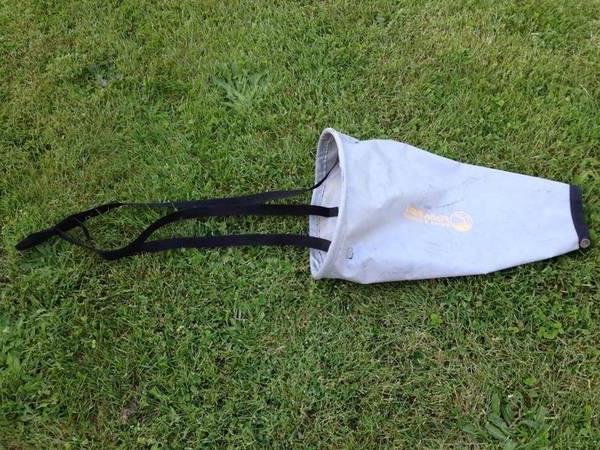
As a rule, the device has the shape of a cone or a pyramid, the base of which is open. The latter is attached using a metal hoop or cross-shaped beams. Four slings are connected to it, with the help of which it is attached to the anchor rope.
Attached to the top of the cone is a pull cable that pulls the anchor. The device has a buoy used to lower and raise the device. You can also determine where the product is located by the buoy.
Methods of using floating anchors
The data is taken from the annual journal RORC 1999. The materials are quite interesting, since in the domestic literature the methods of using floating anchors are outlined in general terms and do not give a complete answer about the advisability of their use in stormy weather conditions. Soviet specialists casually noted only that they are used for iol.
The drogue is discussed in detail in the work of K. Adlard Coles, “Sailing in a Storm.” The author notes that the drift created by the device is more effective in reducing drift in windy weather (the size of the yacht must match the size of the device).
The main danger is that when yawing, the yacht can turn its lag towards the wave and capsize. Yawing causes stress on the anchor and rope. At reversing The ship's rudder may break. It becomes clear that when using the device on a modern yacht with a short keel, the vessel must be set with the sail at the stern to maintain direction to the sea anchor. This will ensure the safety of the craft.
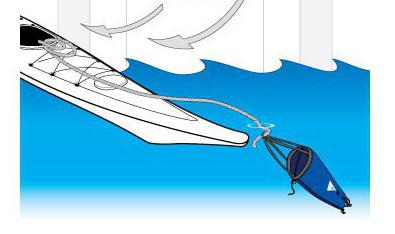
Suitable floating anchor for boat, dinghy and backstay. However, the endurance of the mizzen on the backstay has a limit. Therefore, according to Kohls, the use of a floating anchor is not always justified. Provided that the yacht's holding in the wind is optimal and the load on the rudder is reduced, the yacht will seem to be tied to the stern. It will not wobble, which could cause it to flood. The yacht will expose the cockpit to water.
It should be noted that all the author’s conclusions date back to the middle of the last century. Over the years, the modification of yachts has undergone significant changes, and cockpits began to drain water themselves. The design change allowed us to look at the problem of using such anchors in a new way. Today, such a device is recommended for any yachtsman who goes out to sea.
Applications of floating anchors on rafts
Almost all types of rafts have a drogue. It was developed by the UK National Maritime Institute (NMI). The device is large. Its surface is porous. Along with large pockets for ballast, it is highly effective against capsizing the raft. Tests carried out in Iceland proved that, despite the storm, the raft remains afloat. The second function of the anchor is to slow down the drift.
Sea anchors on modern yachts
The trial was carried out for the RORC at the University of Southampton. It proved that a sea anchor can keep a yacht afloat in high waves. The device helps reduce the speed of the vessel and keeps it downwind. Model tests revealed that the yacht repeatedly avoided lag turns and wave capsizes.
The drogue is recommended for both single-hull and multi-hull yacht models. The position of the device at the stern suggests that waves of great gravity will fall on this part of the vessel. For this reason, all openings must be hermetically sealed. This is given great importance in a special set of rules, which states that yachts must be durable and waterproof. This especially applies to the hull, cabin and deck, which must withstand the onslaught of water.
Primary requirements
It is required that the hatches and boards covering the central entrance be attached to the yacht with a strong strap. The roofs of the cockpit lockers also need close attention. They play a huge role in the waterproofness of the vessel. If these vital parts are lost or damaged, water rushing over the stern will flow in and quickly fill the yacht.
The Department of Transportation has established the dimensions of drogue anchors for ship life rafts and lifeboats. The pipe diameter should be
from 10 to 15% of the yacht's LWL. A sailmaker can make such a floating anchor with his own hands.
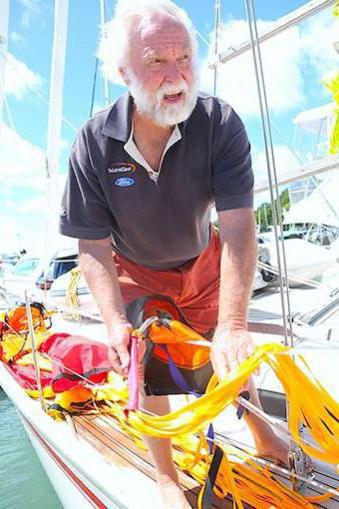
Tug rope
Drifting boat with sea anchor
If the ship cannot swim to the shore, enter the bay, or choose a place convenient for mooring, and is also unable to steer in the wind using the rudder, then you should resort to using a floating anchor. The device will reduce drift.
At great depths, the device makes it possible to place the ship against the wave. The anchor is located on the bow of the vessel, and it is filled in the water. Then a rope is pulled, which slows down the movement of the boat, turning its bow towards the wind.
The length of the rope must be at least five small boat lengths. The cable is released in a weakened state. It should be no shorter than the anchor rope.
To weaken the impact of waves on the ship and prevent flooding, special oils are used. Oils of animal origin are most effective. Spreading over, they create a film that interferes with the formation of crests and dampens the energy of waves.
Mineral oils have lower functionality. It is not recommended to use them on small vessels.
How to use the oil?
Oil periodically pours from the windward side. A mop soaked in it is suspended from the same edge.
There is another way, more economical. Holes are made in a canvas bag or metal can into which crumbled cork, rags or hemp are placed. Oil is poured inside. Then the container is closed, the bag is tied, attached to the anchor rope and etched.
A line is also threaded through the sea anchor so that both ends are on the ship. Then a bag or jar is attached to the line. They must be moved to the anchor at a distance of several meters from it. The empty bag or jar is pulled out onto the ship and refilled with oil. For tench on a floating anchor, it is recommended to stock up on a block. The bag or can is suspended from the anchor line as a float at such a height that it can reach the wave. Oil flowing out of a jar or bag covers the water surface with a film.
Making a floating anchor for boats from PVC with your own hands. Process Features
A floating anchor for a PVC boat should have a size from 2.5 to 4 m. It all depends on the size of the vessel. The speed of the boat is controlled using slings.
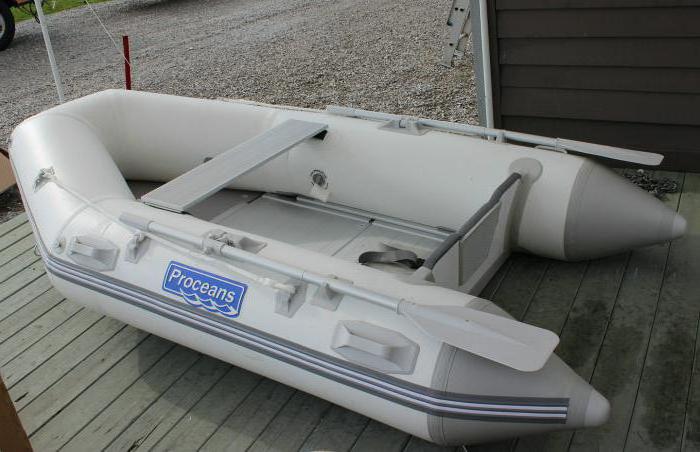
The basis homemade design makes up a dome. The material can be thick polyethylene or synthetic material. The service life of the product depends on this.
It is important that in the center of such a parachute there should be a hole with a diameter of 10-15 cm. Water will enter through it. It is adjustable with a cord. The diameter of the dome, depending on the size of the boat, is 120-150 cm.
Loops are sewn along the length of the circle, through which a rope is threaded to tighten the anchor. There are designs mounted on planks. On the top of them there is a bottle. The lower part of the anchor should be heavier.
The longer the rope by which the anchor is attached to the boat, the more effective the device will be. For example, with a sling length of 1.5 m, the length of the rope should be 10 m.
Second manufacturing method
Typically, this is a rectangular sea anchor. The open hole of the device in this case can have a quadrangular, triangular or any other shape. You can make a floating anchor for a boat using an oar pole using your own hands.
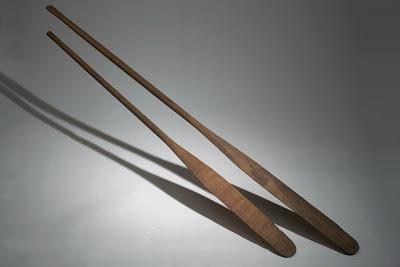
It must be thick. A canvas in the shape of a triangle is lashed to it. A weight is attached to the lower corner of the material.
Often, on PVC boats, a weathervane type anchor or a device with a truncated cone is used. This device is made of canvas. The diameter of the base is approximately 40 cm, the length of the device is 120 cm, the diameter at the top of the cone at the cut is 3 cm. The base of the cone is wrapped around a lycrop and reinforced with four longitudinal stripes made of a similar cable. It ends with a loop for attaching drects.
Third way
You can make a floating anchor for a PVC boat with your own hands using another method. This design involves the use of a wire ring with a diameter of 6-8 mm. A Soviet-made hula hoop made of durable, high-quality aluminum is ideal for the device. It is optimal in shape and size. The size of such a device will allow a small PVC boat to stay afloat in the current and ensure its optimal speed while fishing.

If there is no hula hoop, then the ring is made of wire. Then the hoop is covered with a thin tarpaulin, but it can also be covered with polyethylene. The canvas is stretched so that there is no sagging. The circle is divided into three equal parts, to which meter-long ropes are tied. Their ends are tied. A 5 liter plastic bottle is tied to the upper part, and a weight is attached to the lower part. This way the anchor will take a vertical position in the water and will be able to hold the current.
If fishing is carried out in windy weather, then the plastic bottle is replaced with a half-liter container. In this case, the floating anchor does not go far into the water column, and the waves do not pose a danger. The system does not inflate like a sail and stably holds the vessel in the required current.
It is recommended to lower the device from the boat no more than 5 m. It is not recommended to lower it further, since the device can turn the anchor with its mass, and the meaning of the device will be lost.
It is recommended to have such a simple device with you if you fish in reservoirs. The diameter of the ring is selected depending on the size of the PVC boat.
It should be noted that if you do not have an aluminum hoop, you can resort to using branches with leaves. The branches are cut down and tied tightly. A small weight is attached to them. The bottle is not tied down, as the branches have excellent buoyancy. This device is inferior in functionality to a hoop-based anchor, but it gets the job done.
2. Drifting with a floating anchor.
If the ship cannot reach the shore, enter a shelter or find a place convenient for approaching, and also cannot steer with the wind under its own power and with the help of the rudder, you need to stand on a floating anchor (if the depth is shallow, then on a bottom anchor).
Fig 128 Boat on a floating anchor: 1 - bag of oil; 2 -
buoy; 3 -
steering oar; 4
- cable for selecting the anchor; 5 - anchor; 6
- buyrep
A floating anchor at great depths allows you to place the ship in the cut of the wave and reduce drift. An anchor is placed from the bow, it fills in the water, pulls the draughts and, remaining almost in place, slows down the movement of the vessel, turning its bow to the wind (Fig. 128). To hold the boat with its bow against the wave, a steering oar is additionally used, since it is impossible to keep the boat on the desired course with the steering wheel if there is no movement. The length of the anchor line of a drogue depends on the depth of the anchorage and weather conditions. To increase the holding force of a floating anchor, the length of the anchor rope is increased by uniformly tightening the main rope and the cable for retrieving the anchor. The rope should be at least four to five lengths of a small vessel, and if the wave is large and steep, then in order to avoid jerks, you can attach the rope by etching it by two wavelengths or more until it assumes a horizontal position. The rope for retrieving the anchor is attached with slack and must be no shorter than the anchor rope.
The vessel, with a floating anchor correctly placed and selected in size, should slowly drift to the wind. To weaken the impacts of waves on a ship during drift, their destructive effect and flooding of the ship, you can use animal and vegetable oils, which, spreading over the sea, create a thin film on the surface of the water, which prevents the formation of wave crests, dampens their energy, and softens the impacts of waves on the ship . Mineral oils work much worse and are not recommended for use on small boats. Oil can be periodically poured into the water from the windward side or a mop soaked in oil can be suspended from the same side. There is also a more economical method: holes are pierced in a canvas bag or metal can, crushed cork, rags or hemp are placed and oil is poured. Then the jar is closed, the bag is tied, attached to the anchor rope and poisoned. You can also thread a line through the sea anchor so that both ends are on the ship. Then attach a bag or jar to the line and move it towards the anchor to a distance of several meters from it. The emptied bag or jar is pulled onto the vessel and refilled with oil. For tench on a sea anchor, it is recommended to have a block. The bag or can can be hung from the anchor rope like a float at such a height that it reaches the wave. Oil, pouring out of a bag or jar, covers the water with a thin film.
Rice. 129. floating anchors
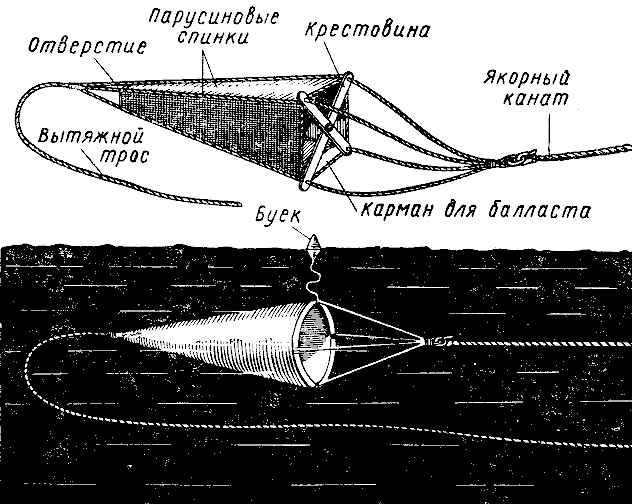
The drogue can be standard or specially made from thick canvas in the shape of a cone with an open base. A metal round hoop is inserted into the base of the cone, to which four lines of equal length are attached with free ends connected into a common loop for tying in the anchor rope. At the top of the anchor there is a fire, to which a guy rope is attached to remove the anchor. The anchor must have a buoy with a float, which determines the location of the anchor and can be found at shallow depths if it is missed. A buoy and a buoy are necessary for lowering and raising a sea anchor and for monitoring its position. You can also make a floating anchor yourself. The ratio of length to width of such an anchor should be 1: 2.25.
The open hole of a sea anchor can be quadrangular (Fig. 129), triangular or any other shape. If you need to quickly build a floating anchor, it can be made from one thick pole (oar) with a triangular canvas lashed to it. A weight or dreck is suspended from the lower corner of the canvas.
The most common dinghy anchor is the weather vane or truncated cone type. This anchor is made from canvas, its diameter at the base is about 40 cm, length about 120 cm, diameter at the top of the cut cone 3 cm. To create the necessary rigidity and strength, the cone is wrapped at the base with lyktros and reinforced with four longitudinal stripes of the same cable, ending with a loop to which the drekt is attached.
If the engine stalls and it is impossible to release the anchor, then the bow of a small vessel can be brought perpendicular to the wave using a sea anchor, which in extreme cases can be replaced with a bucket, basket, shirt with a tied collar and sleeves, or a pillowcase.
More material about anchors:
1. Parking at a "DEAD ANCHOR"
2. How to determine the weight of the anchor and the size of the anchor rope. How many anchors are needed and which one is better? Kurbatov's anchor, Trident anchor. Three designs of a folding cat and how not to lose an anchor.
3. An anchor that cannot be lost. Anchor chain or rope.
4. Anchor chain stopper and anchor lifting device.
5. Anchor. Blueprints.
3. Surf control.
In the surf, steering a vessel has its own characteristics, requiring dexterity, ingenuity and great attention from the navigator.
The surf is the most dangerous area for small boats during rough seas. The waves running onto the shore become steep, and the force of their impacts is very strong. In addition, a current forms in the surf along the shore, especially strong if the water approaches the shore at an angle. The flow of water driven to the shore by the wind and surf goes out to the sea, forming a bottom current. This current, directed from the shore, can carry various objects out to sea. Irregularities in the structure of the shore or structures in the surf create whirlpools. Near the rocky shores, a crowd forms from the collision of oncoming and returning waves. The deeper the coast, the stronger and steeper the surf. The power of breaking waves is especially great near steep rocky shores. As coastal shallows increase, the surf decreases. Together with the wind, the surf creates a dangerous situation for small vessels to approach the shore. A high, fast-moving and steep wave compared to the size of the vessel tends to disable a small vessel. In these conditions, it becomes difficult to control the ship. When caught on the crest of a wave, the ship is completely at the mercy of the waves, its stern with the rudder and propellers may end up in the air, the ship will turn with its lag facing the wave and may capsize.
A large number of accidents with small vessels occur in the surf when ships approach the shore. It is characteristic that 90% of accidents when rescuing people from sunken sea vessels occurs at the moment of disembarkation from the boats to the ground,
During waves, you should not approach an unfamiliar shore. Only in exceptional cases and, moreover, with great caution should one choose a place for throwing ashore. You need to prepare for this very complex maneuver very carefully, without haste. The best place the exit to land will be where the surf is calmer and the shore is sandy and shallow. You cannot approach the rocky shore for landing. If landing on a bank with a rock ripple is inevitable, you need to thoroughly study the place from as short a distance as possible before deciding to approach the shore. However, when exploring the site, you must not enter the surf and breakers zone.
White flecks on the surface of the water some distance from the shore are often signs of strong surf, a hidden reef, shallows or eddies.
The art of steering a small boat in a favorable surf is to prevent the wave from moving the vessel out of a position perpendicular to the wave. It happens that on one wave the ship will pass safely, but another wave takes it out of the correct position, places it with the log facing the wave and turns it over. In the surf it is especially difficult to approach a certain place on the shore. Landing in the surf often requires masterful technique, experience and self-control from the helmsman. Steering a boat in the surf is easier if you steer the ship with a steering oar, for which there must be a rowlock at the stern of the boat. The rudder does not work well when the boat is moving with a passing surf.
When approaching the shore in strong surf, it is necessary to put on life bibs or vests in advance, and if the weather permits, you need to remove excess clothing. All persons on board the vessel must be well aware of their responsibilities when approaching the shore in the surf zone and the procedure for responding to the commands of the boatmaster.
In preparation for landing on the surf, it is necessary to place people and cargo in the boat closer to the side facing the sea, but not at the very tip.
When approaching the shore with the bow, it is necessary to release the anchor or drogue (a large basket or heavy weight dragging along the bottom) from the stern and use it to descend to the shore. If the wave begins to take the boat off course, then by bypassing or picking up the draughts, you can delay the boat and bring it into a position perpendicular to the wave. You must strive to keep the ship all the time on the back slope of the wave facing the sea until the wave breaks up. To do this, when approaching the stern of each large wave, you need to reduce or stop the speed, and as soon as the wave crest approaches the bow of the ship and begins to lift it, move forward and try to keep up with the wave. In the event of an unsuccessful maneuver when approaching the shore with the bow, it is almost impossible to move back. You can approach the shore with the stern, but there is a danger of breaking the propeller and rudder; however, on some boats (such as sixes and fours) it is sometimes better to approach the shore with the stern. In this case, it is necessary to turn the ship with its bow into the sea even before the drill strip, remove the rudder and descend on the rear slope of the wave with an anchor released from the bow.
Just before the shore, you need to try to bring the ship onto the crest of the wave and throw yourself ashore along with the wave. Such a release will make it possible to place the ship further from the coastline (Fig. 130).
Immediately upon touching the ground or when a boat or dinghy is thrown out, people need to jump ashore and, holding the ship by the sides, pull it out with its bow forward beyond the surf line as quickly as possible before the next wave approaches, so that the back wave does not carry the ship out to sea, capsized and did not damage it on the shore.
At this time, let Drektov poison himself and can remain in the water for subsequent withdrawal.
You should be wary of falling behind the wave just before the shore, since when leaving the wave the ship can hit the bottom, pierce the hull and even capsize.
If several boats approach the shore, then one of them anchors, not reaching the surf, and a rope is attached to it, along which the rest of the ships descend to the shore with their stern.
If the shore is deep and the surf forms only one or two breakers, then near the shore the boat must be quickly turned with the lag facing the wave. Then the wave will throw the ship ashore, and the crew must jump off the ship as quickly as possible and pull the boat deep into the shore.

Rice. 130. Approaching the shore in rough weather.
An amateur vessel is not allowed to move away from the shore into the sea during rough seas. Even people with good maritime training do this only when absolutely necessary. Going to sea during rough seas is permissible on ships with sufficient speed, good seaworthiness and a reliable engine. The vessel must sit on an even keel. If the surf is caused by a dead swell when there is no wind or when there is wind from the shore, moving away from the shore is easier. A vessel pulled up to the surf line with the approach of a smaller wave is pushed into the sea by its bow and pulled away from the shore to a sufficient depth, working hard with oars and poles. Then, when the ship begins to rise onto the wave, the engine turns on. A boat running well should go straight across the wave.
For relatively large small vessels, it is easiest to go to sea using a previously given or imported anchor.
The selected slack of the draught is passed through the bow of the vessel onto the bow bollard, and on the boat - through the front bank in such a way that, at the moment of the approach of the wave crest, it is not allowed to move the vessel back to the shore, holding it on a tightly stretched draught.
You should always prevent the vessel from turning with its lag towards the wave, since in this position a boat that has lost control will easily be carried ashore by the surf. When retreating, just as when approaching the shore, you should use the steering oar for control.
On a well-controlled ship going out onto a wave, when its crest approaches, you need to hold your speed somewhat to soften the blow.




